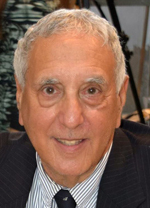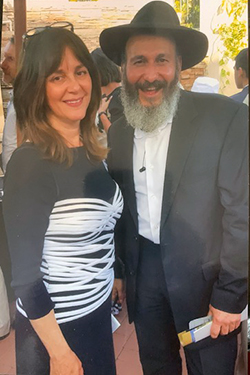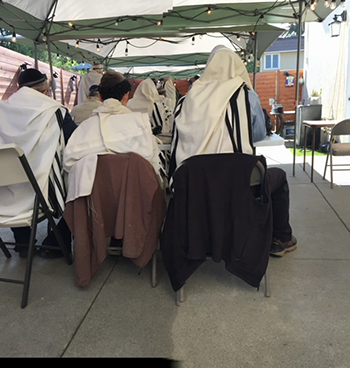

SAN DIEGO — Many rabbis receive honorary doctorates after they have served the Jewish people for 25 years. Thereafter, they may title themselves “Rabbi Doctor.” But that’s not the story of Rabbi Doctor Yehuda (Kenneth) Trestman.
Trestman was a medical doctor long before he became a rabbi. He still is a pulmonary specialist with the Palomar/ Pomerado Hospital Group. But now, he is also a Chabad rabbi who, with his wife Debra, hosts Bais Betzalel Chabad of North County Inland at their home in Rancho Bernardo near the Poway city line. At the hospital, his colleagues call him “Ken” whereas at the shul he is known by his Hebrew name “Yehuda.”
Growing up in Queens, New York, Trestman said his parents wanted him and his brother “to get bar mitzvahed and marry Jewish girls but that was the extent of Torah, Yiddishkeit, or davening in the house. We had a seder, but Passover was more like a get-together to have the family in one place.”
He and his older brother had been raised to become successful professionals, and their parents received their wish. His brother became a lawyer; he became a doctor. In those chance encounters such as at airports when a Chabad rabbi might suggest that he put on tefillin, “it was very alien to me.”
Trestman did his undergraduate work at the State University of New York (SUNY) in Buffalo, then traveled to Guadalajara, Mexico, for his first two years of medical school before transferring to the New York Medical College in Valhalla, New York. Thereafter he did his internship, residency, and chief residency at Lenox Hill Hospital in Manhattan, followed by a two-year fellowship in pulmonary critical care at New York University’s Bellevue Hospital.
During vacations, he and his late first wife Martha (a native of Uruguay) visited San Diego, where a doctor friend had preceded them. The couple decided to move to this city in 1991. Martha, who had grown up in an observant Jewish enclave in Uruguay, suggested that they affiliate with a congregation, which they initially did with the Reform Congregation Adat Shalom. However, when a brit milah for their second son could not be held there because of a scheduling conflict, they had the ceremony at nearby Chabad of Poway.
This began Trestman’s two-decades-long affiliation with Chabad of Poway. That affiliation was shaken by the murder of their friend Lori Gilbert Kaye in the Passover 2019 attack on the congregation by a gunman. The Trestmans chose to sever it after Rabbi Yisroel Goldstein was convicted on federal charges of defrauding charities and the U.S. government. Goldstein was sentenced in January of this year to a 14-month term in federal prison.
Martha Trestman died of breast cancer, leaving the doctor with two sons of school age. At the Chabad Hebrew Academy, which his boys attended, he met his future wife Debra, who had a child of her own. When they married, they adopted each other’s children, and since then have become parents to three more children.
During that period, Dr. Trestman decided to become ba’al teshuva, incorporating more and more Jewish observance into his life. “I spent most of my free time learning when I wasn’t working. I learned about chassidus (piety), halacha (Jewish law), and the Rebbe’s (the late Rabbi Menachem Mendel Schneerson’s) teachings, but at the time all my learning was done in English. I learned mystical concepts, the Torah portions of the week – and that was my focus in my free time. I was working in the intensive care unit, but whenever I didn’t have to be in the hospital, I learned, mainly online.”
After becoming comfortable in his learning about Yiddishkeit, Judaism, “what to do, how to do it, putting on tefillin (phylacteries), saying the proper prayers, and basically leading a Jewish life,” he donned a yarmulke (skullcap) and tzitzit (ritual fringes), grew a beard, and when his colleagues saw him, they asked: “Is this your bar mitzvah or some special day for you?”
He asked not to be scheduled on Fridays and Saturdays so that he could be Shabbat observant. His colleagues “laughed and said, ‘Yeah, right!’ so it was my responsibility to get someone from the fellowship at UC San Diego to cover me on Friday nights and Saturdays. There would be two or three shifts a month, I would have to have covered.”
His change to the Chabad style of dress prompted different reactions. “It’s funny,” he mused. “The non-Jewish world said, ‘Right on, Dr. Trestman, you are dressing up to be who you are.’ Not so much with the Jewish world. They were a little uncomfortable. After a while, they realized this is who I am.”
On one occasion, there was a Jewish patient who was dying, and her husband struggled whether to agree to her being put on a respirator. He was afraid she would never get off the respirator. Trestman recalled that he told the man, “We don’t know that; let’s get her stabilized and let’s get her into a place where she’ll live and then we’ll worry whether she can get off the respirator. You never know.”
So, “I intubated his wife, and I came out and said, ‘I did my part, now we want God to give her a blessing.’ He asked, ‘How can we do that?’ and I said, ‘By putting on tefillin, it makes a vessel for a blessing for you and your wife.’ He said, ‘Sure’ and I put the tefillin on him. A month or so later, she passed on, and he wrote a letter to the hospital saying that I was a very good doctor, but that I should put my black boxes (tefillin) away. Basically, the hospital said to me, ‘if it is a matter of spiritual things, why don’t you refer it to a rabbi?’”
Trestman at that point decided to do just that: become a rabbi. He was accepted to a Chabad-affiliated internet program run out of Minneapolis and after two-plus years he obtained smicha (Orthodox ordination), with graduation ceremonies attended by his family in New York City, headquarters of the Chabad movement.
“I found that being a doctor and a rabbi was an opportunity to provide more care to the patients,” he said. “Being in the trenches taking care of really, really sick people, I used to feel wholly responsible. I had felt I was alone in the world and if I had someone die on me, I took it personally even though I knew I had done my best. But I learned being a doctor that you are partners with God. You are the ambassador, the emissary, for God to work whatever He wants. I realized that I was not alone and that God was there with me. I felt more connected to taking care of patients in that respect.”
Trestman said he sometimes served informally as a Jewish chaplain following his ordination. “One time a nurse called me, about 5 o’clock at night, and told me of a woman from New Jersey who needed a prayer book and advice about the burial of her mother,” he recalled. “Another time a fellow passed away and his children didn’t have the money for a proper burial and I coordinated a burial for this man because the children didn’t want to have anything to do with their father. We provided a proper burial down at the Home of Peace.”
During this period, the Trestmans moved from Poway to Escondido where they purchased a “beautiful home overlooking the San Pasqual Valley and the Wild Animal Park.” But they had a change of heart. With their increasingly observant lifestyle, they should move closer to the synagogue, not farther from it. So they put the house up on the market, but it didn’t sell, even after they lowered their asking price. Disappointed, they took it off the market for a while. A friend suggested to them that they write a letter to be read at the grave of the Rebbe, and an answer would come. They followed that suggestion “and after one week, I got a call from a friend with whom I used to work out at the gym. He asked, ‘Did you ever sell that place?’ I said ‘no, we haven’t been able to.’ The long and short of it was that he loved the house and within two weeks we went on contract on the house.” The Trestmans moved to a Rancho Bernardo home within walking distance of the Chabad of Poway.
After a gunman killed 11 people at the Tree of Life Synagogue in Pittsburgh in October 2018, Trestman said he and his wife expressed to Rabbi Yisroel Goldstein of Chabad of Poway that more attention needed to be paid to the security of the synagogue.
“I begged him to close those doors, and if he doesn’t close those doors, I don’t want the children out of his sight,” Debra Trestman recalled.
“What happened Monday through Friday when we went to morning minyan, I would always go to the front of the shul to make sure that the door was locked,” Dr. Trestman said. “There were a lot of people very concerned, but there seemed to be not as much concern by the rabbi at that time.”
The Trestmans at that time were on very good terms with the rabbi. The family had donated approximately $150,000 for the construction of a mikveh (ritual bath) and other projects at Chabad of Poway. On a more personal level, during the 28 years that they attended that congregation, “I drove Mendel (Goldstein’s son, who succeeded him as rabbi at Chabad of Poway) to school when he was at the Chabad Hebrew Academy. He used to do math in the front seat next to me.” When Mendel had children of his own, the Trestman’s daughter used to pick them up and drive them to the shul.
The Trestmans were at Chabad of Poway the last day of Passover when the shooter came. “My 15-year-old at the time was actually babysitting Mendel’s kids. She put the baby to sleep and wandered into the main entry hall. My other daughter was on the playground and my son was davening with my husband,” Debra Trestman related. After their older daughter heard the gunshots she yelled to smaller children to follow her “and she was able to lead the kids and two adults through the back stairs to another house. Everybody was there but me; I was on the way to shul for Yizkor (memorial prayers), and I arrived after the gunman had left. I found my husband and my son, but my little one was missing for 45 minutes. She had followed a member into someone else’s house. Police didn’t have time to look for my daughter, so I found her myself. Forty-five minutes is a very long time to be looking for a child. After that my husband and I made it our business to provide security at that shul.”
Dr. Trestman said he called together a security council, but Rabbi Goldstein expressed no interest in it. “The common line was, ‘We don’t have any money. If you want security, you will have to contribute. We knew we needed bullet-proof glass; I fundraised $10,000 from a patient who liked me and gave it directly to Steve Arnold (CEO at Legends Home Furnishings) who put together a beautiful glass, bullet-proof shield in front of the shul. Debra and I were very much on the front lines hoping that something like this would never happen again.”
Rabbi Goldstein, who had been wounded in the hand during the gunman’s assault on the synagogue, subsequently announced his retirement, supposedly because he needed to recuperate. Then came the revelation that Rabbi Goldstein had engaged in a 90-10 scheme in which donors “contributed” large sums of money to the synagogue to get a tax write-off, then secretly received 90 percent of their donations back. In another instance, a “donor” got Qualcomm to match his gift to the “Friendship Circle,” a nonprofit organization which was then controlled by Goldstein, and then had his “contribution” refunded. Also, money that had been contributed for the synagogue for the purpose of security was never used – in Debra Trestman’s words, “a betrayal” of the congregation.
When Goldstein left the synagogue under the cloud, his son Mendel stepped in as the leader. The Trestmans and other members of the congregation said they wanted a system of financial transparency, and also suggested that Mendel Goldstein step back and allow a more senior Chabad rabbi to take the leadership of the congregation. According to the Trestmans, these requests “fell on deaf ears.”

Eventually, the Trestmans left Chabad of Poway. Because people were wary of meeting indoors during the COVID-19 pandemic, they decided to establish at the side of their home a prayer tent where a daily minyan could be held outside. At that time, they named their congregation Bais Betzalel (in honor of his father Betzalel) because they were not yet formally affiliated with Chabad.
Since that time, Rabbi Yonah Fradkin, Chabad’s director in San Diego County, and Rabbi Baruch Shlomo Cunin, Chabad’s director for California, have designated Trestman as the North County Inland shaliach (emissary) and have sought to dismiss Rabbi Mendel Goldstein as the Chabad shaliach (emissary) in Poway. Subject to appeal, that decision may go to a beth din (rabbinic court) for final resolution.
In the meantime, many of the congregants who used to attend Chabad of Poway are now attending minyan at the Trestman home, which has been remodeled so that services also can be held indoors. Among those who have attended are Dr. Howard Kaye, husband of the slain Lori Gilbert Kaye and well as members of the Dahan family, whose daughter Noya was 8-years-old when she was wounded by the gunman. Shabbat services are held offsite at a rented facility.
The new congregation has a Torah borrowed from a friend, and the Trestmans said there are plans to “buy our own.” The Trestmans, who donate their time, taking no salary, are both members of a 7-member board that also includes Jordan and Debbie Alpert, Lynda Sohl, Diane Bellovin, and Aubrey Meyerowitz.
“We feel that we are providing something that is really necessary for people in our Jewish community,” Trestman said. “They know that I have been a doctor in the community for 30 years. They know that we have a transparent board. They know that we are being honest and ethical. As a result, it is an amazing experience.”
The congregation may be reached via chabadofnorthcountyinland@gmail.com or by phoning (760) 815 1667.
*
Donald H. Harrison is editor emeritus of San Diego Jewish World. He may be contacted via donald.harrison@sdjewishworld.com

























